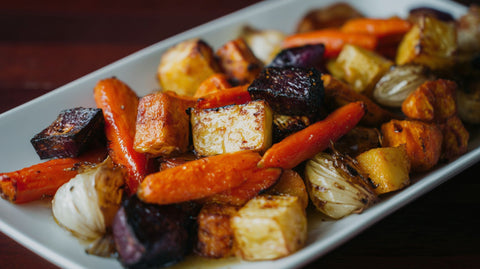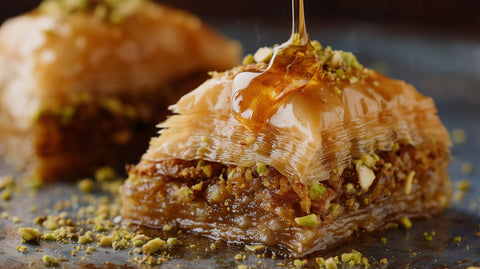Honey enhances savory dishes by balancing flavors, tenderizing meats, and adding caramelized depth to vegetables, sauces, and dressings. From glazes on salmon and chicken wings to roasted vegetables and global marinades, it transforms everyday meals into flavorful, well-rounded creations.
When most people think of honey, they imagine stirring it into tea, spreading it over toast, or drizzling it on yogurt and fruit. Honey has long been celebrated for its natural sweetness, golden color, and smooth texture. Yet what many do not realize is that honey can also shine in savory dishes. This ingredient, created by hardworking bees, has a complexity that complements more than just sweet treats.
The natural sugars in honey caramelize beautifully when cooked, adding depth to meats, vegetables, sauces, and dressings. It balances salty, sour, and spicy flavors, making it a secret weapon for cooks who want to elevate their dishes. From glazing meats to enriching marinades, honey can transform everyday recipes into something extraordinary.
This blog will explore why honey works so well in savory cooking, share classic pairings, highlight popular savory dishes that use honey, and give practical tips for incorporating it into your meals.
Why Honey Works in Savory Cooking
Sweetness in savory recipes is not about making food taste sugary. Instead, it is about balance. Honey provides just enough sweetness to soften bitterness, round out acidity, or mellow spice. This balancing act is why chefs around the world rely on it.
Honey is slightly acidic, which makes it a natural tenderizer for meats. Its sugars caramelize during cooking, producing rich flavors and attractive browning. In sauces and dressings, honey provides viscosity that helps ingredients cling together, creating smooth, flavorful coatings.
Unlike refined sugar, honey also has subtle floral, earthy, or fruity notes depending on the type, which adds layers of flavor. It is this complexity that allows honey to work so well with savory ingredients like garlic, soy sauce, mustard, vinegar, and herbs.
Classic Pairings of Honey with Savory Ingredients
Honey and Meats
Meats are one of the most common areas where honey is used in savory cooking. When brushed onto chicken, pork, or lamb, honey creates a glossy glaze that caramelizes in the oven or on the grill. Its natural sugars develop into a deep, savory sweetness that complements the richness of meat.
Marinades that include honey also tenderize meat while infusing flavor. A mixture of soy sauce, garlic, and honey, for example, is a classic marinade for chicken wings or pork chops.
Honey and Vegetables
Roasting vegetables is one of the simplest ways to elevate their flavors, and honey makes the process even better. A drizzle of honey over root vegetables like carrots, parsnips, or sweet potatoes enhances their natural sugars as they roast. The honey also helps the vegetables develop caramelized edges, adding both sweetness and texture.
Even slightly bitter vegetables benefit from honey. Brussels sprouts roasted with a light coating of honey and balsamic vinegar become savory and sweet at the same time, transforming them into a side dish that converts even picky eaters.
Honey and Cheeses
Cheese and honey is a pairing as old as time. Honey drizzled over creamy goat cheese or brie makes for a simple yet elegant appetizer. The sweetness offsets the tang of the cheese, while the creaminess balances the honey’s viscosity.
For stronger cheeses like blue cheese, honey can soften their sharpness, creating a flavor experience that is bold yet harmonious. This is why honey is so often found on charcuterie boards, where it ties together cheeses, meats, nuts, and fruits.
Savory Dishes Enhanced with Honey
Honey can be added to an impressive range of recipes. Here are some dishes where honey plays a starring role.
Honey-Glazed Salmon
Salmon has a natural richness that benefits from a touch of sweetness. A glaze made from honey, soy sauce, and a splash of lemon juice creates a sticky coating that balances the fatty flavors of the fish. As the salmon bakes or grills, the glaze caramelizes, producing a savory crust with a subtle sweetness.
Spicy Honey Chicken Wings
Chicken wings are beloved for their bold flavors, and honey adds the perfect dimension. By combining honey with hot sauce or chili paste, you create a sticky, spicy-sweet glaze that clings to every wing. The honey mellows the heat just enough to keep the wings flavorful rather than overwhelmingly spicy.
Roasted Vegetables with Honey and Herbs
Seasonal vegetables can easily become the highlight of the table when paired with honey. Tossing vegetables with olive oil, rosemary, thyme, and a drizzle of honey before roasting gives them a sweet-savory flavor that is comforting and sophisticated. Carrots, parsnips, and beets are particularly well suited for this preparation.
Honey-Infused Salad Dressings
Honey is a simple way to improve homemade salad dressings. It not only balances acidity from vinegar or citrus but also gives the dressing a silky texture. Some popular examples include:
- Honey mustard vinaigrette made with Dijon mustard, olive oil, apple cider vinegar, and honey.
- Honey-lime dressing for a refreshing salad topped with avocado and grilled chicken.
Honey in Global Cuisine
- Honey is not limited to one style of cooking. Many cultures have embraced it in their savory dishes.
- In Middle Eastern cuisine, honey is often used with lamb, pairing with spices like cinnamon and cumin.
- In Asian cuisine, honey appears in stir-fries and dipping sauces, particularly when paired with soy sauce, ginger, and garlic.
- Mediterranean dishes often use honey in marinades or drizzled over grilled halloumi cheese.
Tips for Cooking with Honey in Savory Dishes
Honey is versatile, but there are some important things to keep in mind when using it in cooking.
- Choose the right type of honey: Clover honey is mild and works well in dressings, while buckwheat honey has a bolder flavor suited to meats. Wildflower honey has floral notes that can add complexity to roasted vegetables.
- Avoid burning: Honey caramelizes quickly, so it is best added toward the end of cooking when grilling or roasting. This prevents bitterness and preserves its natural flavors.
- Balance flavors: A little honey goes a long way. Start with a small amount and adjust to taste, especially in savory sauces.
- Use honey as a sugar substitute: Honey can often replace sugar in recipes like barbecue sauce or marinades, but use slightly less since honey is sweeter than sugar.
Health Benefits of Using Honey in Cooking
Honey is not only delicious but also offers potential health benefits. While it should still be consumed in moderation, it can be a healthier alternative to refined sugar.
- Honey contains antioxidants, which may help protect the body from damage caused by free radicals.
- It has antibacterial properties, making it useful in traditional medicine for soothing sore throats and aiding digestion.
- The natural sugars in honey provide quick energy, making it a preferred sweetener for athletes.
Because honey has a lower glycemic index than white sugar, it may cause a slower rise in blood sugar levels. This makes it a better choice for people looking to manage their sugar intake, though it should still be used responsibly.
Final Thoughts About Using Honey With Savory Dishes
Honey is far more than a sweet treat for desserts and tea. Its unique flavor and natural properties make it a versatile ingredient that enhances savory dishes in countless ways. From meats to vegetables to dressings, honey provides the perfect balance that brings out the best in other ingredients.
By experimenting with honey in your savory cooking, you can discover new layers of flavor and create meals that are both comforting and exciting. Whether you are making honey-glazed salmon, spicy wings, or a simple salad dressing, this golden ingredient has the power to elevate your dishes.
Next time you reach for honey, do not limit yourself to drizzling it over something sweet. Instead, try it in your next savory recipe and enjoy the way it transforms your meal.
For the perfect touch of natural flavor in your savory cooking, explore the pure, single-source honeys available from Ames Farm.
Frequently Asked Questions About Honey & Savory Dishes
What makes honey a good ingredient for savory dishes?
Honey balances salty, spicy, and acidic flavors while adding natural sweetness and caramelization, making it ideal for meats, vegetables, and sauces.
Can honey be used in place of sugar in savory recipes?
Yes, honey can replace sugar in many savory dishes such as marinades and dressings, but since it is sweeter than sugar, you should use slightly less.
What type of honey works best for cooking?
Mild honeys like clover are great for dressings, while stronger varieties such as buckwheat are better for glazes and marinades on meats.
How do I keep honey from burning when cooking?
Add honey later in the cooking process or use lower heat since honey caramelizes quickly and can burn if exposed to high temperatures for too long.
What are some popular savory dishes that use honey?
Examples include honey-glazed salmon, spicy honey chicken wings, roasted carrots with honey and herbs, and honey mustard vinaigrette.


